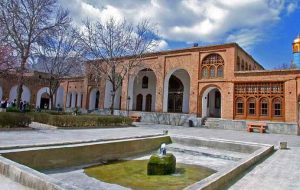Asef Vaziri Mansion: a cultural gem of Kurdish heritage
TEHRAN – The Asef Vaziri Mansion, known as the “Kurdish House,” stands as a testament to the rich cultural identity of the Kurdish tribes and is a significant cultural relic in Sanandaj, the capital of Kordestan province in western Iran. The original structure features a ceremonial hall, various rooms, and corridors dating back to the

TEHRAN – The Asef Vaziri Mansion, known as the “Kurdish House,” stands as a testament to the rich cultural identity of the Kurdish tribes and is a significant cultural relic in Sanandaj, the capital of Kordestan province in western Iran.
The original structure features a ceremonial hall, various rooms, and corridors dating back to the Safavid era, with additional components added during the Qajar and Pahlavi periods. The building was first established by the Motamed Hashemiha family (Amjad al-Ashraf) and later owned by Mirza Mohammad Reza Vaziri, whose efforts led to its final grandeur, including the construction of the entrance, showcasing an Iranian Baroque brick facade, and enhancements to the eastern and western sections during the Asef Divan period.
Managed by the provincial cultural heritage department since 1997, the mansion was reopened in 2003 as the largest anthropology museum dedicated to the Kurdish culture.
Its exquisite architectural features include stucco work, antique sashes, carved stones, intricate mirror decorations, and beautifully embowed arches.
The mansion comprises several sections, including the main entrance, corridors, aqueducts, and water distribution rooms, as well as four gates leading to the outer courtyard, inner courtyard, kitchen garden, and staff yard. In the southwest corner, a traditional Iranian bath showcases distinctive lime designs.

Today, the southern part of the mansion has been transformed into a gallery, while another section has become a charming traditional tea house featuring a brick dome. The main pool has been refurbished, complete with a newly constructed porch that invites visitors to enjoy this cultural treasure.
The Kordestan province is home to towering mountains, wide valleys, and gushing waterfalls. It is a popular destination for mountaineers and nature lovers due to its abundance of river lakes, mineral springs, caves, and wildlife. It is also known for its varied, breathtaking natural beauty and rugged road bends.
The name Kordestan refers to the region’s principal inhabitants. After the Turkish invasion of Iran in the 11th century CE (Seljuk period), the name Kurdistan was applied to the region comprising the northwestern Zagros Mountains. It was during the reign of Abbas I the Great of Iran’s Safavid dynasty (1501–1736) that the Kurds rose to prominence, having been enlisted by Abbas I to help stem the attacks of the marauding Uzbeks from the east in the early 17th century.
AM
